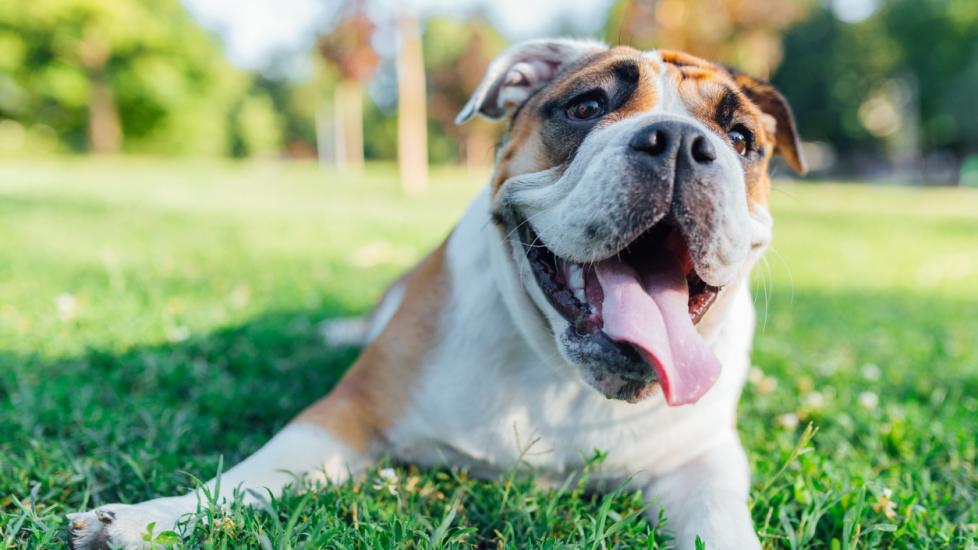Do Dogs Sweat?
On hot summer days or after a particularly long game of fetch, you might wonder: “Do dogs sweat like humans do?” It may not seem like it, but yes, dogs do sweat—they just sweat differently than us. Here’s what to know about dog sweat and how you can help your pup keep cool.
How Do Dogs Sweat?
Instead of sweat dripping down their face or underneath their limbs—common in overheated humans—most dog sweat is released through glands in the paw pads. And, unlike humans, sweating is not an effective way for dogs to cool themselves.
Dogs have two types of sweat glands:
-
Merocrine sweat glands are made of secretory cells and are mostly found in the paws. When a dog is hot or nervous, sweat is released—you might see your dog leave behind light, sweaty footprints as they walk. The sweat evaporates from the hairless paw pads and helps release a small amount of body heat.
-
Apocrine sweat glands are throughout the dog’s body and are not used for cooling. Instead, these produce pheromones for dog-to-dog communication.
The sweat from the merocrine sweat glands in a dog’s paw pads does not have the odor associated with human sweat. In fact, human body odor is the result of skin bacteria mixing with sweat.
Sweat from the apocrine glands is also not an odor us humans can smell. However, the pheromones found in the sweat from the apocrine glands can be picked up by other dogs and are used to communicate.
How Do Dogs Cool Themselves Off?
Neither type of sweat gland is effective at cooling, but that’s no reason for concern—dogs have better ways cool down.
Panting
When a dog is panting, they are rapidly inhaling, humidifying, and exhaling air. This movement causes moisture in the airways to evaporate, which leads to a cooling effect. If your dog is panting a lot post-playtime, make sure he has water readily available.
Vasodilation
Another way dogs cool off is via vasodilation (expansion of blood vessels). When the vessels dilate, warm blood is moved closer to the body’s surface, where it can be cooled. The most effective areas for vasodilation are the face and ears—this is why a dog’s ears and chin may be red when they’re hot.
Should You Shave a Dog?
While it is easy to see how a dog’s coat acts as an insulator in cold weather, many people don’t realize it also helps to keep many dogs cool in warm weather. The reason? Fur slows the transfer of heat from hot weather to the body.
Dogs with heavy double coats (such as German Shepherds, Siberian Huskies, and Golden Retrievers) should not be shaved in warm weather, as this removes one of the body’s mechanisms for staying comfortable. The coat also protects the skin from parasites and UV rays.
But dogs with a single coat of hair (including Poodles, Shih Tzus, and Yorkies) can be shaved without the detrimental effects to thermoregulation.
Heatstroke in Dogs
Vasodilation, panting, and an appropriate fur coat are not always enough to cool a dog to a safe body temperature. When dogs overheat, they are at risk of heatstroke, which can be fatal if not recognized and treated rapidly.
Heatstroke occurs when a dog is exposed to warm temperatures, which causes the body temperature to rise. This often occurs when a dog is left outside, is exercising, or is in a non-airconditioned car during warm weather. The normal body temperature for a dog is 99.5 F–102.5 F. Body temperatures above 106 F can lead to multiple organ failure and death.
Signs of heatstroke should be identified quickly, and the dog should be taken to a veterinarian immediately. The veterinarian will begin appropriate cooling measures and provide supportive care.
Signs of heatstroke include:
-
Excessive panting
-
Incoordination
-
Rapid heart rate
-
Vomiting
-
Unconsciousness
While on the way to the vet, offer your dog cool water to drink. Cool water can also be poured on the dog to keep him cool, but wet towels should never be applied, as this insulates the heat.
Some dogs are more prone to heatstroke, like very old or young dogs. Dogs with short/flat faces, called brachycephalic breeds, are especially at risk for heatstroke even at moderate temperatures. These dogs (English Bulldogs, French Bulldogs, Pugs, etc.) have restricted airways that make panting less effective at cooling.
How to Keep Your Dog Cool
Dogs do not cool down by sweating the way humans do, so care is needed to prevent overheating. Dogs should always have access to shade and cool water when playing outside. In summer, exercise should be kept to early mornings or late evenings when temperatures are lower. And remember: Never leave a dog unattended in a car, as heat rises rapidly in just a few minutes.
Featured Image: iStock/Ivan Pantic
